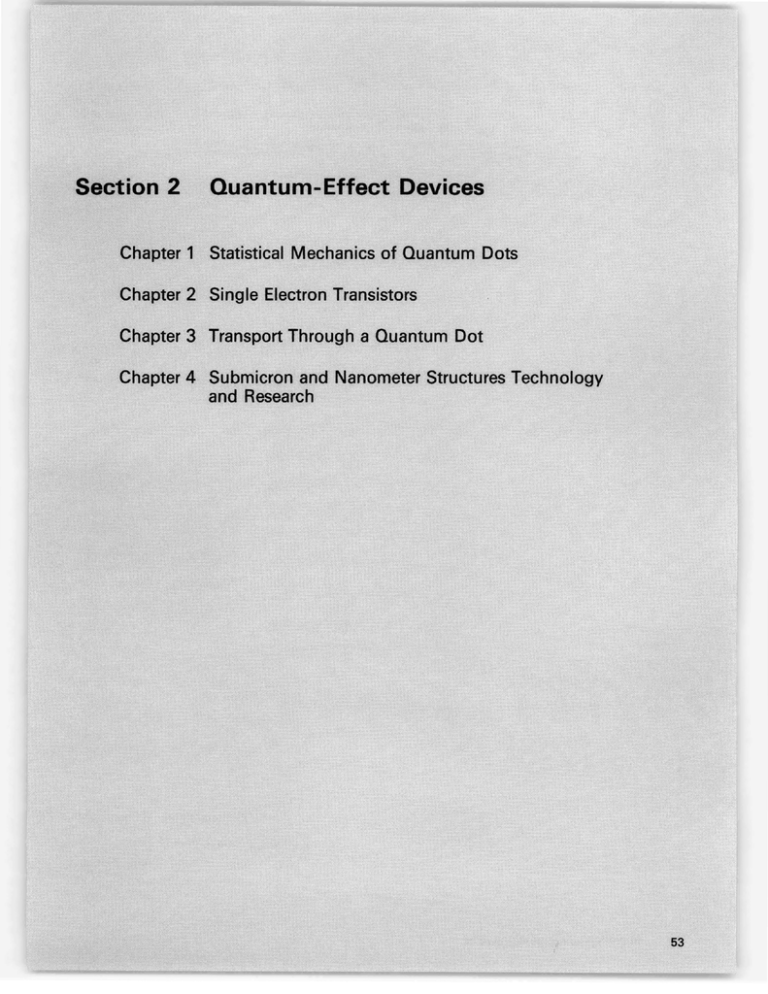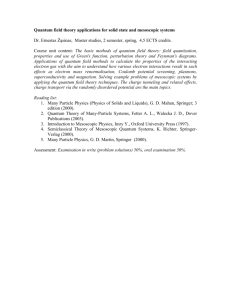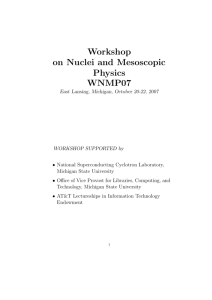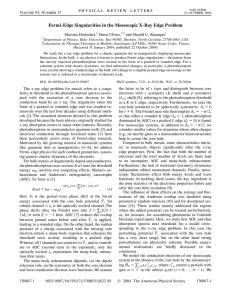Section 2 Devices Quant~;m-Effect Chapter 2 Single Electron Transistors
advertisement

Section 2 Quant~;m-Effect Devices Chapter 2 Single Electron Transistors Y:, SUDmicrori and Nanometer Structures Technology and Research 54 RLE Progress Report Number 134 Chapter 1. Statistical Mechanics of Quantum Dots Chapter 1. Statistical Mechanics of Quantum Dots Academic and Research Staff Professor Boris L. Altshuler, Dr. Richard Berkovits, Dr. Aaron Szafer Graduate Students Michael Faas Technical and Support Staff Imadiel Ariel 1.1 Project Description Sponsor Joint Services Electronics Program Contract DAAL03-92-C-0001 We are investigating equilibrium properties of quantum dots (isolated metallic systems with sizes smaller than the typical length of an electron dephasing). Until recently, we concentrated on such properties of an individual dot as capacitance and electric and magnetic susceptibility. The most dramatic manifestation of the quantum nature of the magnetic polarizability takes place for a multiply connected geometry, e.g., for a ring, and is known as a persistent current. This current is a metallic system response to the magnetic flux through the hole. It can exist even when there is no field in the material, and it does not dissipate. Due to the impurity or surface scattering of the conductivity electrons, there is certain dispersion of the properties in the ensemble of macroscopically equivalent samples. Therefore, we must consider the sample to sample (mesoscopic) fluctuations as well as ensemble averaged properties such as persistent current. Earlier' we developed a theory on the persistent current neglecting the interaction between the electrons. This problem involves two energy scales: (1) the mean energy spacing between the exact one electron states in a random potential A, and (2) the inverse typical time of an electron diffusion around the sample hIt = Ec, also known as the Thouless shift. The dimensionless ratio Ec/A is the sample conductance in natural units e2 /h. We found that the mean root square of the mesoscopic fluctuations of the persistent current is of the order of Ece/h, while the averaged persistent current, although nonzero, is much smaller and determined by A. The persistent current was recently observed 2 and found to be orders of magnitude larger than the theoretical predictions in the absence of the interaction between electrons. Also, superconductive-like fluctuations cannot explain why the effect is so large. On the other hand, the magnitude of the observed persistent current is more or less consistent with the charging energy e2 /R, where R is the radius of a ring. This was one of the motivations for us to study dielectric properties of mesoscopic systems. We have developed a technique to investigate the local charge fluctuations and local electric fields within a mesoscopic system. We have found that, due to quantum interference, there are long range correlations in these local fluctuations (similar to the well-known Friedel oscillations). These correlations determine the additional energy caused by the Coulomb interaction between the fluctuations, and, therefore, their contribution to the thermodynamics. We have calculated the distribution of electric fields outside a disordered, neutral quantum dot as well as the quantum correction to its polarizability. Although both of the effects are small, they are very important ideologically from the point of view of the scaling theory of metal-insulator transition, which we believe are observable. , B.L. Altshuler, Y. Gefen, and Y. Imry, Phys. Rev. Lett. 66: 88 (1991); B.L. Altshuler and B.Z. Spivak, Zh. Eksp Teo. 92: 607 (1987). 2 L.P. Levy, G. Doland, J. Dunsmuir, and H. Bouchiat, Phys. Rev. Lett. 64: 2074 (1990); V. Chandrasekhar, R.A. Webb, M.Y. Brady, M.D. Ketchen, W.J. Gallagher, and A. Kleinsasser, Phys. Rev. Lett. 67: 3578 (1991). 55 Chapter 1. Statistical Mechanics of Quantum Dots These small effects are caused by the screening of the Coulomb interaction. Due to this screening, additional energy is determined only by the charge distribution in a layer near the sample surface of a width of the screening length. As a result, interaction between the charge fluctuations is not sufficient to account for the persistent current. On the other hand, there is another magnetic flux dependent contribution to the Coulomb energy: the interaction between the charge fluctuations and the confining potential in a quantum dot (e.g., a finite work function of a metallic grain is determined by a dipole layer on the surface). The energy of the local charge fluctuations in the field 56 RLE Progress Report Number 134 of this layer apparently depends on the magnetic field and explains the observed persistent current. This interaction can have a number of important and observable consequences such as substantial mesoscopic fluctuations of the work function and its dependence on the external parameters such as low magnetic field. Publications Altshuler, B.L. "Thermodynamics of Mesoscopic Systems." Paper presented at the International Symposium on Nanostructures and Mesoscopic Systems, Santa Fe, New Mexico, May, 1991.







